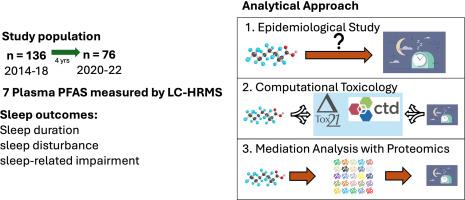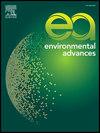Per-and polyfluoroalkyl substances and disrupted sleep: mediating roles of proteins
Q2 Environmental Science
引用次数: 0
Abstract
Background
Per-and polyfluoroalkyl substances (PFAS) contamination may disrupt sleep through disrupted metabolic and immune functions. The study aims to investigate the association and potential mechanism between PFAS and sleep.
Methods
We included 136 young adults recruited between 2014-2018 and 76 were re-assessed between 2020-2022. Additional 8 participants only had complete data between 2020-2022. Plasma PFAS (PFOS, PFOA, PFHxS, PFHpS, PFPeS, PFNA, PFDA) were measured at both visits using liquid-chromatography high-resolution mass spectrometry. Plasma proteins were measured by Olink® Explore 384 Cardiometabolic and Inflammation Panel I. Sleep duration was self-reported at both visits along with follow-up sleep disturbance and sleep-related impairment using validated instruments. We utilized multiple linear regression to explore the association between individual PFAS (in tertile) and these sleep outcomes. PFAS associated with sleep outcomes were subjected to computational toxicology analysis using the Comparative Toxicogenomics Database and Toxicology in the 21st Century database to identify potential genetic links between them. Mediation analysis using proteomic data was then performed to confirm the findings from computational toxicology analysis.
Results
At baseline, one tertile increase in PFDA was associated with 0.39 (95 % CI: 0.05, 0.73) hours of shorter nightly sleep duration, and, at follow-up, PFHxS and PFOA were associated with 0.39 (95 % CI: 0.05, 0.72) and 0.32 (95 % CI: 0.01, 0.63) hours shorter sleep duration, respectively. One tertile increase in PFOS exposure was associated with a 2.99-point increase in sleep disturbance scores (95 % CI: 0.67, 5.31) and a 3.35-point increase in sleep-related impairment scores (95 % CI: 0.51, 6.20). Computational toxicology and mediation analyses identified potential mediating roles for several proteins in the PFAS-sleep associations, including 11-beta-dehydrogenase isozyme 1 (HSD11B1), cathepsin B (CTSB) and several immune system-related proteins.
Conclusion
Future large scale epidemiological and mechanistic studies should confirm our findings and test effect measure modification of the associations by age.

全氟和多氟烷基物质与睡眠紊乱:蛋白质的中介作用
背景全氟和多氟烷基物质(PFAS)污染可能会通过扰乱新陈代谢和免疫功能来破坏睡眠。本研究旨在调查 PFAS 与睡眠之间的关联和潜在机制。方法我们纳入了 2014-2018 年间招募的 136 名年轻成人,其中 76 人在 2020-2022 年间接受了重新评估。另有 8 名参与者只有 2020-2022 年间的完整数据。血浆中的 PFAS(PFOS、PFOA、PFHxS、PFHpS、PFPeS、PFNA、PFDA)在两次访问中均使用液相色谱高分辨质谱法进行了测量。两次就诊时,均使用经验证的仪器对睡眠时间、随访睡眠障碍和睡眠相关损伤进行了自我报告。我们利用多元线性回归来探讨单个 PFAS(三等分)与这些睡眠结果之间的关联。利用比较毒物基因组学数据库和 21 世纪毒理学数据库对与睡眠结果相关的 PFAS 进行了计算毒理学分析,以确定它们之间的潜在遗传联系。结果在基线时,全氟辛烷磺酸(PFDA)浓度每增加1个三等分位点,每晚睡眠时间就会缩短0.39(95 % CI:0.05,0.73)小时;在随访时,全氟辛烷磺酸(PFHxS)和全氟辛酸(PFOA)浓度每增加1个三等分位点,睡眠时间就会分别缩短0.39(95 % CI:0.05,0.72)小时和0.32(95 % CI:0.01,0.63)小时。全氟辛烷磺酸暴露量每增加一个百分位数,睡眠障碍评分就会增加 2.99 分(95 % CI:0.67, 5.31),睡眠相关损伤评分就会增加 3.35 分(95 % CI:0.51, 6.20)。计算毒理学和中介分析确定了几种蛋白质在全氟辛烷磺酸与睡眠关系中的潜在中介作用,包括 11-beta-dehydrogenase isozyme 1 (HSD11B1)、cathepsin B (CTSB) 和几种与免疫系统相关的蛋白质。
本文章由计算机程序翻译,如有差异,请以英文原文为准。
求助全文
约1分钟内获得全文
求助全文
来源期刊

Environmental Advances
Environmental Science-Environmental Science (miscellaneous)
CiteScore
7.30
自引率
0.00%
发文量
165
审稿时长
12 weeks
 求助内容:
求助内容: 应助结果提醒方式:
应助结果提醒方式:


